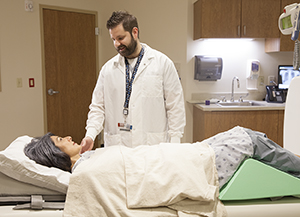A
B
C
D
E
F
G
H
I
J
K
L
M
N
O
P
Q
R
S
T
U
V
W
X
Y
Z
Topic IndexLibrary Index
Click a letter to see a list of conditions beginning with that letter.
Click 'Topic Index' to return to the index for the current topic.
Click 'Library Index' to return to the listing of all topics.
Having an X-ray
An X-ray uses a small amount of radiation to make images of your bones and organs. X-rays are most often used to look for bone or joint problems, or to check the heart and lungs (chest X-ray). They are also used to look for any hard deposits of minerals or salts in your body, such as kidney stones. You may also have an X-ray to check for problems in the bowel such as a blockage or free air in the belly (abdomen). X-rays are also used to look for a foreign object in your body, such as metal. This can be from an injury or a swallowed object.

Tell the X-ray technologist
Tell them if you:
Before your test
Before the test starts, you may be asked:
-
To remove your watch, jewelry, or clothes with metal closures from the part of your body being X-rayed. These items can block part of the image.
-
To put on a hospital gown
-
About your overall health and any medicines you take
During your test
Here is what to expect during the test:
-
You may be asked to sit, stand, or lie on a table.
-
A lead apron may be draped to protect the areas of your body not being X-rayed.
-
With an X-ray of your chest or belly, you may have to take a deep breath and hold it for a few seconds.
-
Each exam usually needs at least 2 X-ray views. You may need to move your body before each new X-ray view.
After your test
Your healthcare provider will discuss the test results with you during a follow-up appointment or over the phone.
They may advise other imaging tests (such as an MRI or a CT scan) or more X-ray views if needed. This is done to confirm the diagnosis.
Online Medical Reviewer:
Marianne Fraser MSN RN
Online Medical Reviewer:
Raymond Turley Jr PA-C
Online Medical Reviewer:
Shaziya Allarakha MD
Date Last Reviewed:
3/1/2024
© 2000-2025 The StayWell Company, LLC. All rights reserved. This information is not intended as a substitute for professional medical care. Always follow your healthcare professional's instructions.